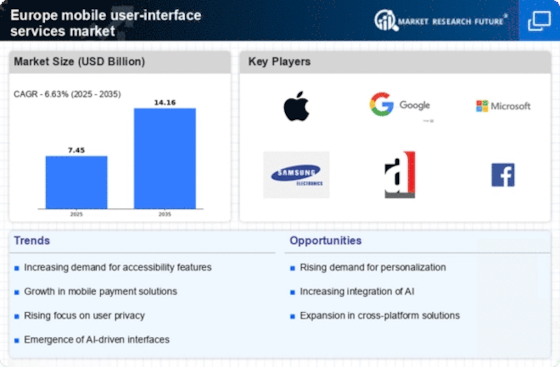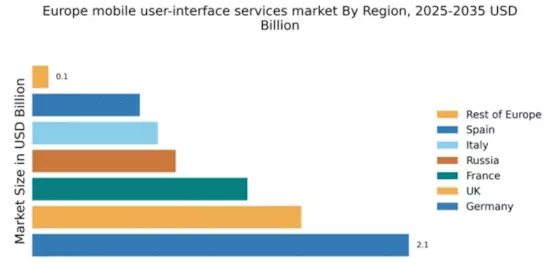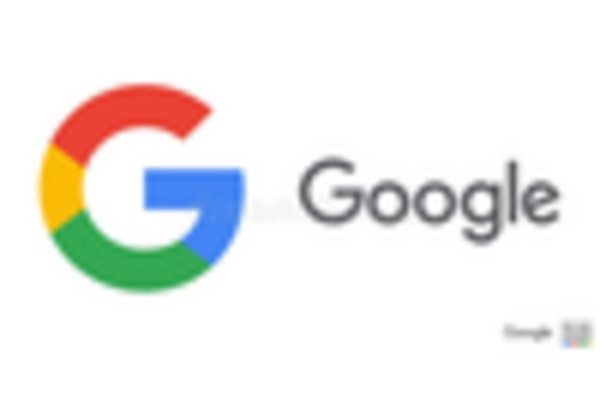Rising Demand for Mobile Applications
The mobile user-interface-services market in Europe is experiencing a notable surge in demand for mobile applications across various sectors. As businesses increasingly recognize the necessity of mobile presence, the need for intuitive and engaging user interfaces becomes paramount. In 2025, the mobile application market in Europe is projected to reach approximately €100 billion, indicating a robust growth trajectory. This demand drives innovation in user-interface design, compelling service providers to enhance their offerings. The competitive landscape intensifies as companies strive to deliver superior user experiences, thereby propelling the mobile user-interface-services market forward. Furthermore, the proliferation of smartphones and tablets contributes to this trend, as users expect seamless interactions and visually appealing designs. Consequently, the focus on user-centric interfaces is likely to shape the future of mobile applications in Europe.
Regulatory Compliance and Data Privacy
Regulatory compliance and data privacy concerns are increasingly shaping the mobile user-interface-services market in Europe. With the implementation of stringent regulations such as the General Data Protection Regulation (GDPR), companies must prioritize user data protection in their interface designs. This regulatory landscape compels service providers to adopt best practices in data handling and user consent management. In 2025, it is anticipated that compliance-related investments will account for approximately 15% of total expenditures in the mobile user-interface-services market. As organizations navigate these complexities, the emphasis on transparent and user-friendly interfaces becomes essential. This focus not only ensures compliance but also fosters user trust, which is vital for long-term success in the competitive mobile landscape.
Technological Advancements in UI Design
Technological advancements play a crucial role in shaping the mobile user-interface-services market in Europe. The integration of artificial intelligence (AI) and machine learning (ML) into user-interface design processes enhances personalization and user engagement. In 2025, it is estimated that AI-driven interfaces could account for up to 30% of new mobile applications launched in Europe. These technologies enable developers to create adaptive interfaces that respond to user behavior, thereby improving overall satisfaction. Additionally, the rise of augmented reality (AR) and virtual reality (VR) applications necessitates innovative user-interface solutions that cater to immersive experiences. As these technologies evolve, they present both challenges and opportunities for service providers in the mobile user-interface-services market, compelling them to stay ahead of the curve and continuously innovate.
Increased Investment in Digital Transformation
The mobile user-interface-services market in Europe is significantly influenced by ongoing digital transformation across industries. Organizations are allocating substantial budgets towards enhancing their digital capabilities, with an estimated €200 billion earmarked for digital initiatives in 2025. This investment encompasses the development of user-friendly mobile interfaces that facilitate seamless interactions with customers. As businesses strive to improve operational efficiency and customer engagement, the demand for sophisticated user-interface services rises. This trend is particularly evident in sectors such as retail, finance, and healthcare, where user experience is critical. Consequently, the mobile user-interface-services market is poised for growth as companies seek to leverage advanced design solutions to meet evolving consumer expectations and remain competitive in a rapidly changing landscape.
Growing Importance of Cross-Platform Compatibility
Cross-platform compatibility emerges as a pivotal driver in the mobile user-interface-services market in Europe. As users increasingly access applications across various devices, the demand for interfaces that function seamlessly on multiple platforms intensifies. In 2025, it is projected that over 50% of mobile applications will prioritize cross-platform functionality, reflecting a shift in user expectations. This trend compels developers to create adaptable user interfaces that maintain consistency and performance across different operating systems. Consequently, service providers in the mobile user-interface-services market must invest in technologies and frameworks that facilitate cross-platform development. This focus not only enhances user satisfaction but also broadens the potential user base, ultimately driving growth in the market.


















Leave a Comment